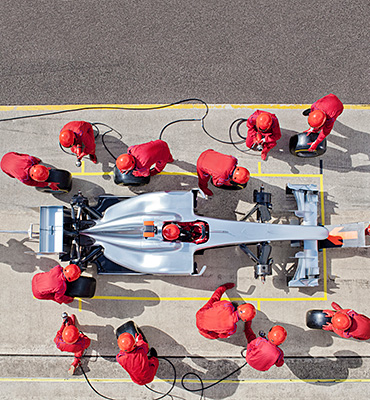Bridgestone undergoes a digital evolution
Our fourth Leading lights boardroom featured some compelling insights from Bart Kerkhofs, the IT Director behind Bridgestone’s digital transformation.

In the fourth session of the Leading Lights boardroom programme, organised in partnership with CIO Magazine, Bart Kerkhofs, IT Director for EMIA (Europe, Middle East, India and Africa), explained how the market has changed for tyre giant Bridgestone.
What did this ultimately mean for Bridgestone IT? A veritable evolution. Bridgestone produces tyres, rubber products such as golf balls, and provides services related to tyres and mobility. In our session, Kerkhofs discussed their step-by-step approach to modernisation and adopting agile working.
Adopting intelligent infrastructure
Our global CTO, Colin Bannon, opened the boardroom session by describing how our own organisation is going through a transformation too. He explained how we’ve addressed the issue of our own technical debt to be able to support our customers' target architectures: "Digital transformation is essentially not possible without an infrastructure that keeps up with developments. Think of telemetry, networks, think of resilience, security..." According to Bannon, the bottom line is that infrastructure needs to become more intelligent. "We see our infrastructure becoming part of, for instance, our customers' DevOps and test environments. That creates obligations on our side that go beyond 'we are not at fault'. We need to facilitate and even improve customer experiences."
Here, the various technologies no longer form silos, but solutions for a whole range of devices. This, for example, brings changes for customer service, which needs to be more comprehensive. As the oldest telco in the world, we also have to deal with technical debt. We have over the past few years been working on an infrastructure that is more decoupled and based on components. These components can be used for both customised contracts and the generic market.
Mobility and agility
After Bannon’s introduction, Bart Kerkhofs stepped in to explain how the market has changed for the tyre giant: "The market in Europe is very competitive. This prompted us not to wait, but to take the lead in transformation." Bridgestone summarised the changes in the automotive industry with the acronym CASE: connected, autonomous, shared, electric. These changes are the result of global developments such as climate change, Coronavirus, digitalisation and urbanisation.
In order to respond to the developments, Bridgestone developed several propositions such as predictive maintenance and fleet management services. Such initiatives require significant investments in data analytics. The team needed to solve tricky questions, such as how do you collect and access data, how do you analyse and process it and finally, how do you harness it for innovative solutions? This all led to the establishment of the Bridgestone Mobility Solutions business unit, which now has 1.2 million connected vehicles.
Unsurprisingly, Bridgestone sees the ‘tyre of the future’ as something very different from the tyres we are used to: lighter, quieter, more efficient, more sustainable, safer and above all, more digital and smarter. The tyre of the future will learn from the car, road and weather. In collaboration with Microsoft and AWS, Bridgestone offers a damage management system for connected tyres.
Moving towards a target architecture
So, what did these innovations mean for Bridgestone IT? Bart Kerkhofs explained: "Bridgestone had a traditional IT operation. We had a complex, decentralised IT environment, which was not agile. So, we started looking at the capabilities and platforms that we required."
The team’s main focus, like a dot on the horizon, was a target architecture. The first step on the way to achieving this was to reduce technical debt. The goal was to develop solutions that were simpler and more flexible. "In order to communicate our ambitions to the board" Kerkhofs explained, "we compared the situation at the time with the desired outcome. We made it clear that the architecture and way of working at that time would lead to a downward spiral."
An evolution not a revolution
Bridgestone’s digital transformation has been a major undertaking. From cybersecurity to the cloud, HR to manufacturing systems, data platforms to the digital core, many areas have been overhauled or redesigned to modern standards for the first time. This meant that the way of working - the IT operating model - also came under scrutiny.
Kerkhofs made it very clear: "The way of working was aimed at eliminating risk as much as possible. We did not want security to be affected, but we definitely wanted more agility and scalability." The operation’s starting point was highly principled - to think about the role of IT organisation. Through several inspirational sessions, self-assessments and help from Gartner, it became clear which direction to take: modernisation was needed in the areas of governance, sourcing, way of working and budgeting. "In terms of maturity, we did not necessarily want to go to level five - we do not have to be Spotify," Kerkhofs quipped, "we wanted an evolution, not a revolution."
Collaboration and integration
This self-examination and the subsequent evolution had a positive outcome; Bridgestone’s IT organisation became more innovative and collaborative. Operational efficiency improved. A high degree of automation was essential, as was the integration of all kinds of initiatives, led by IT. The team aimed to offer an excellent customer experience without any hurdles. Kerkhofs was keen to highlight: "You often hear about introducing a start-up mentality in large companies, but we saw this differently. We wanted to use the large scale of the organisation, rather than create lots of units."
One step at a time
It was a major operation that progressed step by step. The team made sure to raise awareness among all those involved. It was essential to create a close collaboration between business and IT. They decided to learn first what agile working really meant before trying to implement it. “After all, you have to learn to crawl before you can walk, let alone run", observed Kerkhofs. They selected their new cloud competence centre as the use case for the learning process.
Kerkhofs described the current phase of transformation as crawling, but also cautiously starting to walk: "For us, the crawling phase is an internal IT programme. In the walking phase we arrive at digital IT products, and then comes the running, or realising digital business products with multi-functional teams."
In the final discussion the participating CIOs, who are often involved in major digital transformations themselves, found the Bridgestone case both recognisable and instructive. Many questions were raised, including those about the results achieved and the collaboration with the business in agile teams.
Lessons from Bridgestone
During the session, Bart Kerkhofs shared the following advice:
- Begin your transformation with your people, culture, mindset and competences
- Prioritise data throughout the organisation
- Embrace agility, speed and new technologies
- Work with minimum viable products
- Bring the right people together within the organisation
- Build an IT backbone that enables scaling
- Make sure you properly deploy and use your ecosystem, and especially your IT partners

